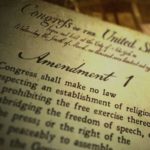From the colonial era, relations between European settlers and Native American nations have been complicated. In 1803 Congress authorized and funded an expedition led by Meriwether Lewis and William Clark for exploration of the region and for better knowledge about American Indians of the Northwest in order to develop trade. About 30 years later, the United States forced the removal of Native Americans from their lands to make way for white American settlement. Congress and the president made treaties with Native American nations, but those treaties were not always respected as the United States continued to expand into the west. After Native Americans enlisted and served in both World War I and World War II, Congress passed legislation to begin to address longstanding Native Americans claims against the United States Government.
Tribal Government
This lesson examines the varied structures and functions of tribal government as well as the relationship these nations have with the United States.
Hispanic and Latino Heritage and History in the United States
Since 1988, the U.S. Government has set aside the period from September 15 to October 15 as National Hispanic Heritage Month to honor the many contributions Hispanic Americans have made and continue to make to the United States of America. Our Teacher’s Guide brings together resources created during NEH Summer Seminars and Institutes, lesson plans for K-12 classrooms, and think pieces on events and experiences across Hispanic history and heritage.
Landmark Supreme Court Cases
In a partnership with the National Constitution Center, Khan Academy talked to constitutional scholars about ten of the most significant Supreme Court cases in history. Teachers can use this lesson as a supplemental resource during their Supreme Court unit to show how constitutional scholars can debate the outcomes of Supreme Court cases, as well as the impact these cases have had on the United States.
Freedom of the Press: New York Times v. United States

This documentary examines the First Amendment’s protection of a free press as well as the historic origins of this right and the ramifications of the landmark ruling in New York Times v. United States in which the Supreme Court that prior restraint is unconstitutional. The federal government could not prevent newspapers from publishing the Pentagon Papers. A lesson plan, Defenders of Liberty: The People and the Press, accompanies the video.
Landmark Lessons
Find lesson plans generated by teachers who completed the Cultures of Independence workshop at the Historical Society of Pennsylvania. The lessons illustrate how local and national history can be taught through a focus on a physical place and primary sources. Criteria for selecting lessons also included the teaching of historiography and, when appropriate, connections to the founding principles of the United States. Use a lesson from your region, or become inspired to create your own.
LGBTQ Activism and Contributions Primary Source Set
The lives, freedom struggles, and social and cultural contributions of lesbian, gay, bisexual, transgender, and queer (LGBTQ) people make up a rich part of the history of the United States, and primary sources from the Library of Congress provide valuable opportunities to explore individuals, movements, and events from the nation’s LGBTQ history.
Guide to the State Statues in the National Statuary Hall Collection
The National Statuary Hall Collection in the United States Capitol is composed of statues donated by individual states to honor persons notable in their history. The entire collection now consists of 100 statues contributed by 50 states. All 50 states have contributed two statues each. Thirty-five statues are displayed in National Statuary Hall while others have been placed in other parts of the Capitol including the Crypt, the Hall of Columns, and the Capitol Visitor Center.
Founding Documents: The Constitution Podcast
After just six years under the Articles of Confederation, a committee of anxious delegates agreed to meet in Philadelphia to amend the government. The country was in an economic crisis — citizens couldn’t pay their debts, the government couldn’t really collect taxes, and rebellions were cropping up in states across the nation. The existing government had the potential to drive the country to ruin. So fifty-five men gathered to determine the shape of the new United States.
The document that emerged after that summer of debate was littered with masterful planning, strange ideas and unsavory concessions. The delegates decided they’d be pleased if this new government lasted fifty years. It has been our blueprint for over two centuries now. This is the story of how our Constitution came to be.
This short episode includes a one-page Graphic Organizer for students to take notes on while listening, as well as discussion questions on the back side.
Civil Rights
While the Reconstruction Amendments were an important step in ensuring equal rights for all people, regardless of race, racial injustices throughout the United States continued into the late 19th and 20th centuries, leading to the Civil Rights movement of the 1960s, and the passages of Supreme Court decisions and legislation, including Brown v. Board of Education, the Civil Rights Act of 1964, and the Voting Rights Act of 1965. Visit the National Constitution Center’s learning module to learn more about the freedom struggle and civil rights.